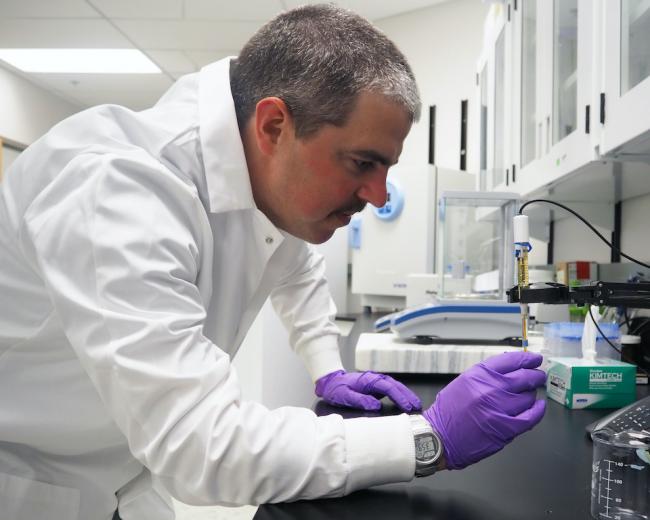Articles Menu

[Editors: We don't think ecosocialists should be ignorant of the tech schemes under experimentation but we do need to maintain a sharply critical attitude.
This sounds a lot like carbon sequestration on land - who really knows if it will stay down there, and there is evidence in some cases it does not!
Another obvious question is how much energy would have to be expended to put it down there?
And we are wondering what side effects there would be of changing the composition of rock on the ocean floor in terms of marine life?
Note that the authors do say: “Negative emissions technologies such as Solid Carbon do not replace the need for urgent emissions reductions but are needed alongside deep decarbonization if we are to limit average global temperature increase to 1.5 degrees Celsius above pre-industrial levels,” ]
September 8, 2021
It may be possible to sequester carbon dioxide in subseafloor ocean basalt at a scale that would bring down global atmospheric concentrations of this predominant greenhouse gas (GHG) that is driving climate change, according to scientists with the Pacific Institute for Climate Solutions (PICS) Solid Carbon project.
Human activity adds around 51 gigatons (Gt or 51 billion tons) of GHGs to the atmosphere each year, and new research indicates carbon dioxide (CO2) storage on a gigaton scale is possible.
Geochemical simulations were conducted by scientists at the University of Calgary (UCalgary), a research partner with the PICS “Solid Carbon” negative emissions technology (NET) feasibility study led by Ocean Networks Canada (ONC), a University of Victoria initiative.
The results have been published in the Environmental Science & Technology journal article entitled “Alkalinity Generation Constraints on Basalt Carbonation for Carbon Dioxide Removal at the Gigaton-per-year Scale.”
Using a series of geochemical calculations, the UCalgary scientists have demonstrated that gigaton-scale carbon dioxide storage is possible when plumes of captured CO2 are directly injected into deep ocean basalt. There, the CO2 reacts with minerals, and over time, forms a solid carbonate rock.
This is an alternate approach to experiments conducted in Iceland where CO2 is injected in a dissolved state, and mineralizes rapidly, within two years, at shallow depths.
Lead author and UCalgary Associate Professor Benjamin Tutolo says rapid mineralization using dissolved CO2 is water-intensive, costly and difficult to scale up. He says the UCalgary simulations indicate carbon mineralization on the Gt scale, “if basalts are given time to react.”
“The reaction needn’t be completed in days or even months as long as the CO2 doesn’t escape before the process is complete, even if it takes centuries,” he says. Aquifers beneath the ocean floor are typically topped with more than 300 metres of “very impermeable” sediment, and residence times of water in these aquifers are inferred to be on the order of thousands or tens of thousands of years.
“Human-caused GHG emissions are driving us toward tipping points at which dire consequences of climate change will be inevitable,” adds Tutolo. “Solid Carbon’s technology could help make a significant dent in atmospheric concentrations of CO2 through utilizing the vast quantity of global sub-seafloor basalts, with the calculated capacity to store up to 250,000 Gts.”
These findings advance the Solid Carbon goal of permanently and safely sequestering carbon dioxide. Using renewable energy aboard a floating ocean platform, the project aims to extract CO2 from the air and inject it into subseafloor basalt where it will mineralize into rock.
Kate Moran, ONC president and Solid Carbon principal investigator says a field demonstration at Cascadia Basin is urgently needed because Solid Carbon presents an undeniable opportunity to durably store decades of anthropogenic emissions needed to meet planetary climate targets.
PICS Executive Director Sybil Seitzinger welcomes the findings, saying that the world needs these potentially game-changing technologies in the climate-action toolbox.
“Negative emissions technologies such as Solid Carbon do not replace the need for urgent emissions reductions but are needed alongside deep decarbonization if we are to limit average global temperature increase to 1.5 degrees Celsius above pre-industrial levels,” says Seitzinger.
This research was supported by the PICS Solid Carbon Theme Partnership and the Natural Sciences and Engineering Research Council of Canada.
The Pacific Institute for Climate Solutions develops impactful, evidence-based climate change solutions through collaborative partnerships that connect solution seekers with experts from BC’s four leading research universities. PICS is hosted and led by UVic in collaboration with the University of British Columbia, Simon Fraser University and the University of Northern British Columbia.
-- 30 --
A media kit containing a PDF of FAQs and high-resolution photos is available on Dropbox. Animations of Solid Carbon’s proposed technology can be viewed at solidcarbon.ca
[Top photo: Benjamin Tutolo of the Solid Carbon team measuring the pH of water in his laboratory, University of Calgary. Solid Carbon is led by Ocean Networks Canada, an initiative of UVic. Credit: Qin Zhang]